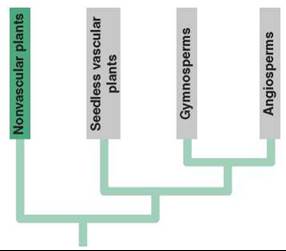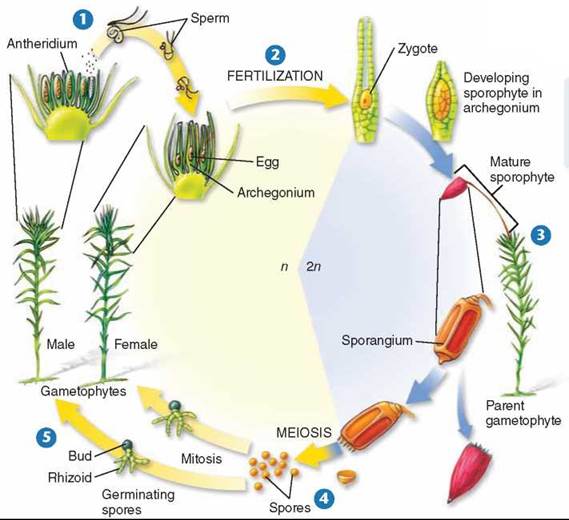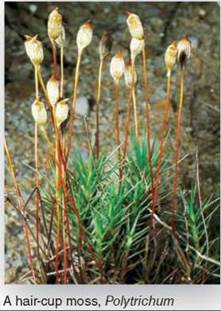THE LIVING WORLD
Unit Seven. Plant Life
32. Evolution of Plants

Liverworts and Hornworts
The first successful land plants had no vascular system—no tubes or pipes to transport water and nutrients throughout the plant. This greatly limited the maximum size of the plant body because all materials had to be transported by osmosis and diffusion (see chapter 4). However, these simple plants are highly adapted to a diversity of terrestrial environments. Only two phyla of living plants, the liverworts (phylum Hepaticophyta) and the hornworts (phylum Anthocerophyta), completely lack a vascular system. The word wort meant herb in medieval Anglo-Saxon when these plants were named. Liverworts are the simplest of all living plants. About 6,000 species of liverworts and 100 species of hornworts survive today, usually growing in moist and shady places.
Primitive Conducting Systems: Mosses
Another phylum of plants, the mosses (phylum Bryophyta), were the first plants to evolve strands of specialized cells that conduct water and carbohydrates up the stem of the gametophyte. The conducting cells do not have specialized wall thickenings; instead they are like nonrigid pipes and cannot carry water very high. Because these conducting cells could at the most be considered a primitive vascular system, mosses are usually grouped by botanists with the liverworts and hornworts as “nonvascular” plants. Today about 9,500 species of mosses grow in moist places all over the world. In the Arctic and Antarctic, mosses are the most abundant plants. “Peat moss” (genus Sphagnum) can be used as a fuel or a soil conditioner. The moss Phy- scomitrella patens, whose genome was sequenced in 2006, has been the subject of many genetic studies. In figure 32.5, you can see that the majority of the moss life cycle consists of the haploid gametophyte generation (the green part of the plant), which exists as male or female plants. The diploid sporophyte (the brown stalk with the swollen head) grows out of the gametophyte of the female plant 3, after the egg cell has been fertilized. Cells within the sporophyte undergo meiosis to produce haploid spores 4 that grow into gametophytes 5.


Figure 32.5. The life cycle of a moss.
On the haploid gametophytes, sperm are released from each antheridium (sperm-producing structure) 1. They then swim through free water to an archegonium (egg-producing structure) and down its neck to the egg. Fertilization takes place there 2; the resulting zygote develops into a diploid sporophyte. The sporophyte grows out of the archegonium, forming the sporangium at its apex 3. The sporophyte grows on the gametophyte, as shown in the photo, and eventually produces spores as a result of meiosis. The spores are shed from the sporangium 4. The spores germinate, giving rise to gametophytes 5.
Key Learning Outcome 32.3. While liverworts and hornworts totally lack a vascular system, mosses have simple soft strands of conducting cells.